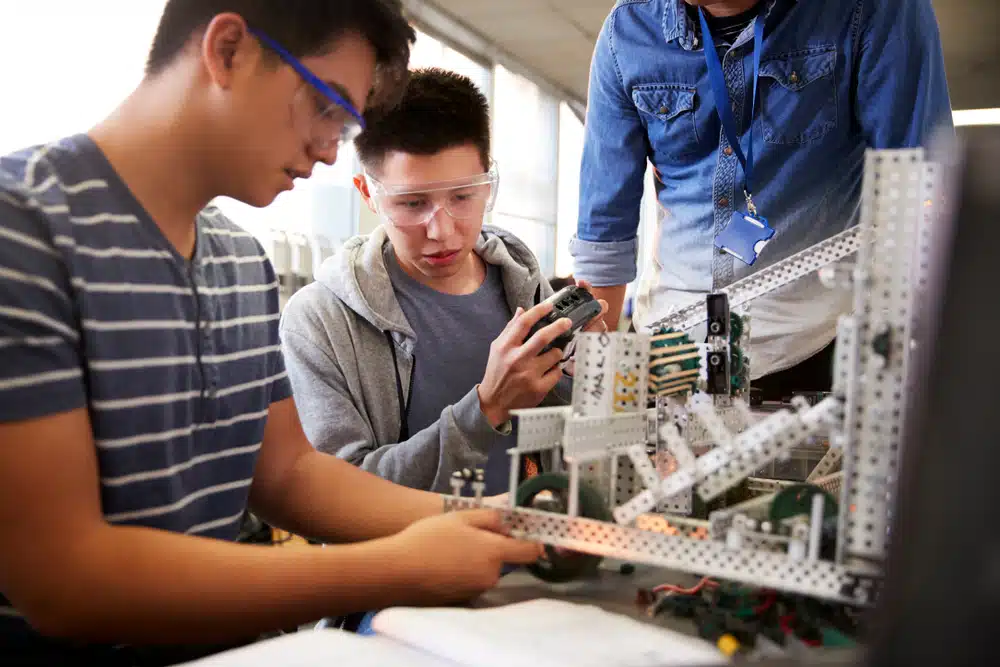B.E.S.T. Robotics Design Contest: The Future of Robotics
Robotics is becoming a pivotal field in STEM education. It combines elements of Science, Technology, Engineering, and Mathematics, offering students a comprehensive approach to learning. This enhances their knowledge and skills in these critical domains.
Integrating robotics into STEM education brings numerous benefits. It prepares students for future challenges and provides them with essential skills needed in an ever-evolving world.
A key advantage of incorporating robotics in STEM education is the hands-on learning experience it provides. This makes STEM concepts tangible and directly applicable to real-world situations. Through robotics, students not only understand but also apply scientific principles as they design, build, and program robots. This provides a practical extension of the theoretical concepts taught in classrooms.
This hands-on learning approach can also help students retain knowledge more effectively, as they are able to see the results of their efforts and learn from their mistakes.
Robotics also teaches students important problem-solving skills, which are critical in the field of STEM. In the process of building and programming a robot, students learn how to identify problems, brainstorm solutions, and test their ideas.
They also learn how to work collaboratively in teams, which is another important skill in STEM fields. By working together to build and program robots, students learn how to share ideas, delegate tasks, and support one another in achieving a common goal.
Another significant advantage of incorporating robotics into STEM education is that it can inspire students to pursue careers in STEM fields. Robotics is a rapidly growing industry, and by exposing students to robotics at a young age, educators can help generate interest in STEM careers.
Robotics also offers students an opportunity to explore various STEM fields and disciplines, such as Computer Science, Electrical Engineering, and Mechanical Engineering. Through robotics, students can learn about the different types of STEM careers available to them and the skills they need to pursue them.
In addition to these benefits, robotics also promotes creativity, innovation, and critical thinking skills. By designing and building robots, students are encouraged to think outside the box and come up with creative solutions to complex problems.
They also learn how to innovate and adapt their designs based on their observations and testing, a skill that is valuable in any STEM field.
The B.E.S.T. Robotics Design Contest is an annual competition that challenges students to design and build robots to complete specific tasks within a given theme.
Participating in the contest provides several benefits to students interested in STEM fields. It offers a hands-on learning experience that allows students to apply STEM concepts to real-world problems.
The competition also fosters collaboration and teamwork as students work together to design and build their robots. Additionally, students develop important soft skills, such as communication and presentation skills, that are essential for success in any field.
In conclusion, this robotics contest is an exciting and challenging competition that offers students an opportunity to explore STEM concepts through robotics. By participating in this competition, students can gain valuable experience and skills that will benefit them in their future STEM endeavors.
Introduction: B.E.S.T. Robotics Design Contest
The competition, known as the B.E.S.T. (Boosting Engineering, Science, and Technology) Robotics Design Contest, has a rich history and background that have helped it become one of the most prestigious robotics competitions for middle and high school students in the United States.
The first contest was held in 1993 in Texas to inspire and encourage students to pursue careers in STEM fields. The competition was created by a group of engineers and educators who wanted to develop a way to provide hands-on experience in engineering and technology to students.
Since its inception, the contest has grown to become a national competition, with teams from all over the country participating. The competition is open to all schools, homeschool groups, and youth organizations, regardless of their location or size.
The competition consists of several stages, beginning with the kickoff event, where teams receive the game rules and details about the challenge. Teams then have six weeks to design and build their robots with the guidance of their coaches and mentors.
The robots are evaluated based on their performance, the engineering design process, and the team’s marketing presentation. The performance evaluation involves testing the robots’ abilities to complete the tasks specified in the game rules.
The engineering design process evaluation assesses the teams’ creativity, innovation, and problem-solving skills in designing and building the robot. Finally, the marketing presentation evaluation measures the team’s ability to communicate and market their robot to judges and other teams.
Over the years, the contest has inspired thousands of students to pursue careers in STEM fields. Many former participants have gone on to pursue degrees in engineering, computer science, and other STEM-related fields.
Overview of the Theme and Rules
The theme of the contest varies each year, but it always focuses on a problem related to science, engineering, or technology. The theme for the competition is announced at the kickoff event, which is held at the beginning of the competition season.
The theme for the B.E.S.T. Robotics Design Contest typically involves solving a problem that is relevant to the community or the world at large.
Once the theme has been announced, teams have six weeks to design and build their robots. The rules for the competition are outlined in the game manual, which is provided to teams at the kickoff event.
The game manual includes information about the tasks that the robots must complete as well as the rules and regulations that teams must follow.
The tasks that the robots must complete vary from year to year, but they always relate to the theme of the competition.
For example, if the theme is renewable energy, the tasks might involve collecting and storing energy from solar panels or wind turbines. If the theme is space exploration, the tasks might involve navigating a simulated Martian environment and collecting samples.
Teams are evaluated on three main criteria: performance, engineering design process, and marketing presentation. The performance evaluation involves testing the robots’ abilities to complete the tasks specified in the game manual.
The engineering design process evaluation assesses the teams’ creativity, innovation, and problem-solving skills in designing and building the robot. Finally, the marketing presentation evaluation measures the team’s ability to communicate and market their robot to judges and other teams.
What are the judging criteria for the B.E.S.T. Robotics Design Contest?
The performance of the robots is a crucial component of the competition, as teams are evaluated based on their ability to complete the tasks specified in the game manual.
The performance evaluation in the contest is designed to test the robots’ abilities to complete the tasks specified in the game manual.
The tasks typically involve navigating a simulated environment, collecting and storing objects, or performing other actions related to the theme of the competition. The robots are evaluated on their speed, accuracy, and ability to complete the tasks in the specified amount of time.
The competition uses a scoring system that assigns points for each task completed to evaluate the robot’s performance.
The point system is outlined in the game manual and based on the task’s difficulty and complexity. For example, tasks that require more skill or precision may be worth more points than relatively straightforward tasks.
In addition to the point system, the performance evaluation also takes the robots’ reliability and consistency into account.
Robots that are able to complete the tasks consistently and without error are more likely to score higher in the performance evaluation than robots that experience technical difficulties or errors.
The performance evaluation is conducted in a controlled environment, such as a gymnasium or auditorium, where the robots are able to navigate the simulated environment and complete the tasks.
The competition provides a variety of obstacles and challenges for the robots to navigate, such as ramps, obstacles, and other hazards.
The robots are controlled by the students using remote controls or autonomous programming. Autonomous programming involves programming the robot to complete tasks without human intervention. Teams may choose to use a combination of remote control and autonomous programming to complete the tasks.
The performance evaluation is a critical component of the B.E.S.T. Robotics Design Contest, as it allows teams to showcase their robots’ abilities and demonstrate their understanding of STEM concepts. The evaluation also provides valuable feedback to teams, as they can identify areas for improvement and refine their robots’ design and performance.
Assessment of the Engineering Design Process
The B.E.S.T. (Boosting Engineering, Science, and Technology) Robotics Design Contest challenges middle and high school students to design and build a robot that can complete a series of tasks related to a specific theme.
The engineering design process is a critical component of the competition, as it guides teams through the process of designing and building their robots. Assessment of the engineering design process is important in ensuring that teams are able to effectively and efficiently design and build their robots.
An engineering design process is a systematic approach to problem-solving that is used to design, develop, and test new products, systems, or processes. The process involves several key steps, including problem identification, research, design, prototyping, testing, and evaluation.
In the contest, teams are expected to follow the engineering design process as they design and build their robots.
Assessment of the engineering design process in the contest is based on several key criteria, including the team’s ability to:
- Identify the problem and design challenge: Teams must identify the specific problem or challenge they are trying to solve and clearly articulate it in their design process.
- Conduct research: Teams must research the specific theme of the competition and identify relevant information that will inform their design.
- Design and prototype: Teams must create a detailed design plan that outlines the specifications and requirements of their robot. They must also create prototypes to test their design and make any necessary changes.
- Test and evaluate: Teams must test their robot to ensure it is functioning as intended and evaluate its performance based on the specific tasks outlined in the game manual.
- Refine and iterate: Teams must refine their design and iterate on their prototypes based on feedback from testing and evaluation.
Assessment of the engineering design process in the B.E.S.T. Robotics Design Contest is typically conducted through a combination of written documentation, interviews, and observation.
Teams are required to document their design process in a detailed engineering notebook, which is reviewed by judges to assess their understanding and application of the engineering design process.
Judges may also conduct interviews with team members to gain a better understanding of their design process and decision-making. In addition, judges observe the team as they test and evaluate their robot to assess their ability to refine and iterate on their design based on feedback.
Assessment of the engineering design process is a critical component of the contest, as it ensures that teams are able to effectively and efficiently design and build their robots.
By following the engineering design process, teams are able to approach the competition in a systematic and organized manner and are more likely to produce successful results.
Judging the Team’s Marketing Presentation
In addition to the design and performance of the robot, the contest also requires teams to showcase their marketing and presentation skills. Each team is required to create a marketing presentation that highlights their robot’s design, features, and performance.
This presentation is an important aspect of the B.E.S.T. Robotics Design Contest, as it allows teams to demonstrate their ability to communicate effectively and promote their robot to potential customers and investors.
Judging the team’s marketing presentation is based on several key criteria, including:
- Creativity and originality: Judges evaluate the team’s ability to create a unique and memorable marketing presentation that stands out from the competition.
- Clarity and organization: Judges assess the team’s ability to clearly communicate their robot’s design, features, and performance in a well-organized and structured manner.
- Audience engagement: Judges evaluate the team’s ability to capture and maintain the attention of the audience through effective storytelling, visuals, and presentation skills.
- Overall impact: Judges consider the overall impact of the marketing presentation, including its ability to promote the robot to potential customers and investors.
- Adherence to the theme: Judges evaluate the team’s ability to incorporate the specific theme of the competition into their marketing presentation, and to convey how their robot relates to the theme effectively.
Teams are typically given a set amount of time to present their marketing presentation, which may include a combination of visual aids such as slideshows, videos, and physical props.
The presentation is typically followed by a question-and-answer session, during which judges may ask teams to provide additional information or clarification.
In addition to the actual presentation, judges may also evaluate teams based on their preparation and planning process. This may include reviewing the team’s marketing plan, promotional materials, and outreach efforts leading up to the competition.
Assessment of the team’s marketing presentation is typically conducted by a panel of judges who have expertise in marketing, communication, and entrepreneurship. Judges may include industry professionals, educators, and community leaders who are familiar with the goals and objectives of the contest.
How does participating in the B.E.S.T. Robotics Design Contest benefit students interested in STEM fields?
The contest offers students a unique opportunity to apply STEM (Science, Technology, Engineering, and Math) concepts in real-world situations.
Through this competition, students are challenged to design and build a robot that can perform specific tasks and meet specific performance requirements. This requires students to apply their knowledge of physics, mechanics, electronics, programming, and other STEM fields to solve practical problems and create innovative solutions.
One of the key benefits of the contest is that it allows students to see how the concepts they learn in the classroom can be applied in real-world situations. This helps make STEM education more relevant and engaging for students and can inspire them to pursue careers in STEM fields.
Through the contest, students also gain valuable experience working in teams, solving problems collaboratively, and communicating their ideas and solutions effectively.
They learn how to plan and manage a project, how to prioritize tasks and allocate resources, and how to adapt to unexpected challenges and setbacks.
By participating in the contest, students also have the opportunity to develop important skills and qualities that are highly valued by employers in STEM fields.
These include critical thinking, problem-solving, communication, teamwork, and creativity. These skills are essential for success in many STEM careers and can help students excel both in school and in their future careers.
In addition to the academic and career benefits of the contest, participating in this competition can also be a lot of fun and rewarding for students.
They have the opportunity to meet and interact with other students who share their passion for STEM and to showcase their skills and talents in a supportive and challenging environment.
Colleges and universities are increasingly looking for well-rounded students who have demonstrated their abilities in a variety of areas, including STEM.
Participation in the contest can help students stand out in the college application process, particularly if they have achieved high rankings or awards in the competition. This experience can also be a valuable topic to write about in college essays or discuss in interviews.
In addition to participating in competitions like the B.E.S.T. Robotics Design Contest, students can also benefit from professional guidance and support in the college application process.
Here at AdmissionSight, our team of college consultants provides expert advice and guidance to students and families throughout the application process. We can help students develop a strategic plan for college admissions, identify and apply to their dream schools, and optimize their chances of success.
If you are a student interested in STEM fields and looking for ways to showcase your skills and stand out in the college application process, hurry and book an initial consultation today!









































